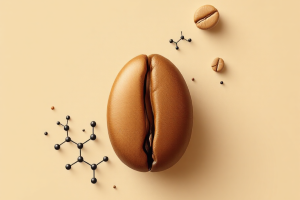Chitosan and Caffeine – A Smart Duo for Health, Cosmetics, and Sustainability

Chitosan, a versatile biopolymer derived from chitin, is already a well-established player in pharmaceuticals, medicine, cosmetics, and environmental applications. But things get even more interesting when chitosan joins forces with another powerful compound: caffeine. While it might sound like the base of a high-energy supplement, this combination is in fact a promising area of research – with applications reaching far beyond the food industry.
Caffeine – More Than Just a Wake-Up Call
Caffeine is one of the most widely consumed alkaloids worldwide, best known for its stimulating effects on the central nervous system. But there’s much more to caffeine than just alertness:
- Antioxidant: Caffeine acts as a natural free radical scavenger, protecting cells from oxidative stress.
- Anti-aging: New studies suggest caffeine may slow down age-related cellular degeneration by modulating telomerase activity and reducing inflammation.
- Metabolic boost: Caffeine promotes fat breakdown (lipolysis) and supports weight management.
- Neuroprotective: In animal studies, caffeine has shown protective effects in models of Alzheimer’s and Parkinson’s disease.
- Cardiovascular support: In moderate amounts, caffeine improves vascular elasticity and may lower the risk of cardiovascular disease.
- Skin-active: In cosmetics, caffeine enhances circulation and tightens skin – popular in anti-cellulite and under-eye treatments.
Chitosan – A Smart Carrier for Caffeine
Caffeine is water-soluble and rapidly absorbed – which is both an advantage and a challenge. In combination with chitosan, however, caffeine's full potential can be better utilized through controlled release and targeted delivery.
1. Controlled Release for Supplements & Pharma
Encapsulation in chitosan-based nanoparticles or hydrogels allows for sustained caffeine release. Studies show that chitosan-coated alginate beads not only slow release but also reduce bitterness – ideal for nutraceutical applications.
2. Acid Reduction in Beverages
Chitosan can neutralize organic acids in coffee, improving taste and making it gentler on the stomach – a clear advantage for sensitive consumers.
3. Cosmetic Applications
Chitosan-based films with embedded caffeine enhance local blood flow and are used in formulations against cellulite, puffiness, and tired skin. The combination of chitosan’s biocompatibility with caffeine’s bioactivity makes for powerful topical treatments.
4. Chitosan-Caffeine in Sustainable Materials
A more unusual but innovative use: chitosan–caffeine blends serve as bio-based preservatives in wood protection. Caffeine acts as an antimicrobial agent, while chitosan improves binding and durability on the material surface.
Looking Ahead: Chitosan + Caffeine = Functional Innovation
The combination of chitosan and caffeine is a great example of how natural compounds can be paired to create intelligent, functional formulations for health, beauty, and sustainability.
Whether in nutritional supplements, medical delivery systems, cosmetic actives, or even eco-friendly material protection – the synergy of chitosan and caffeine offers a wealth of innovation. As research continues to unlock their full potential, this duo will likely play a growing role in next-generation biotech solutions.
Sources
Banožić, M. et al. (2021). Improving the controlled delivery formulations of caffeine in alginate hydrogel beads combined with chitosan and carrageenan. Molecules.
Kleeberg, H. (1999). Untersuchung der Säurebindungseigenschaften von Chitosan bei Kaffeegetränken. TU Berlin.
Mokhtar, M. et al. (2021). Microfluidics-based production of chitosan-gellan nanocomplexes encapsulating caffeine. International Journal of Biological Macromolecules.
Ismail, M. et al. (2022). Effect of Addition of Chitosan Derived From Shrimp Shell to Reduce the Caffeine Content of Powder Coffee. Journal of Chemical Natural Resources.
Kolbuszewska, M. et al. (2023). Characteristics of Chitosan Films with the Bioactive Substances—Caffeine and Propolis. Bioengineering.
Teacă, C.A. et al. (2022). Chitosan–caffeine formulation as an ecological preservative in wood protection. Wood Science and Technology.
Herrera-Rivera, Z. et al. (2024). Caffeine-induced delay in cellular senescence and oxidative damage. Cell & Bioscience.
Saavedra, M.J. et al. (2014). Study of natural adsorbent chitosan and derivatives for the removal of caffeine from water. Water Quality Research Journal.


